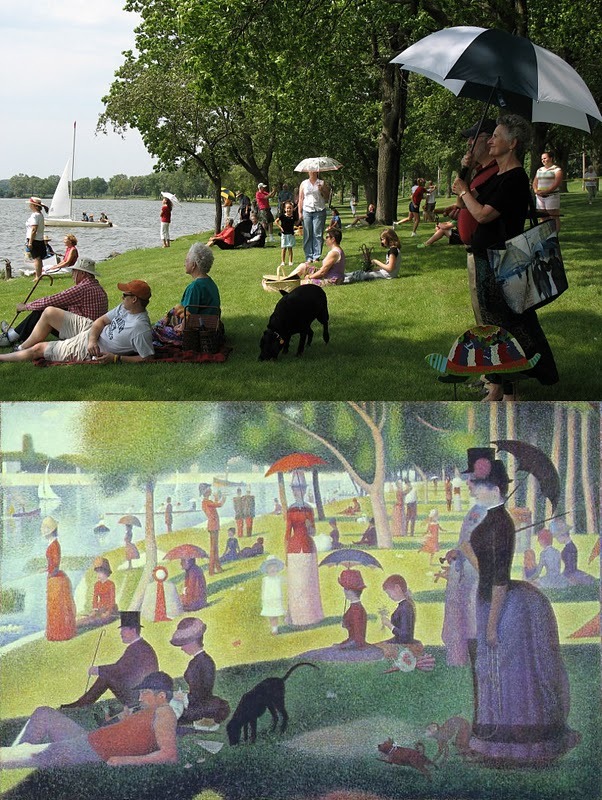Writing in the library
I had an excellent ~6 hours of solid writing/wrestling with my master's paper one day last week. At this stage, I'm still drafting raw text and am not in the polish stage where I'm honing the thoughts in the sentences and paragraphs, and ensuring my themes and the story I'm telling are all working together, which is what I would call "the writing phase". Right now, I'm at the "vomit text" stage, if I may be forgiven for such a phrase.
Here's how I structured my time and my environment to encourage me to work:
- I staked out a table in Davis Library, 7th floor. There are plenty of big tables that are hardly used, wall plugs are nearby for the MikeBook, and -- most importantly -- the books on the shelves are from the Asian collection, printed in Chinese and Japanese -- so I'm not tempted to browse them during my breaks!
- I have MacBreakz set to annoy me every 50 minutes with some simple ergonomic exercises. In the preferences, I removed the ability to banish the window, so that I have to force myself to stand, stretch, walk, go to the bathroom -- anything but sit and stare at the screen. The breaks last 10 minutes.
- During that break, I put some Genteal drops in my eyes to keep them my moist. My cataract doctor said that, when you work on a computer, you tend to not blink, which dries out your eyes, causing strain. The regular breaks to look out the window and away from the screen (MacBreakz includes eye exercises) and the wetting drops help keep my eyes healthy.
- Most important -- Fred Stutzman's Freedom app, to keep me from surfing the web when I should be working. I usually set it for 125 minutes, to really enforce that I should be working.
- For the paper, I had some clear goals defined: insert the new stats graphs, write text describing the graphs, create new stats tables as needed from my original data. Instead of floundering, I had specific tasks in mind.
- Also important: work in batch mode. When adding graphics into my Word file, insert one, got to the next page, insert one, etc. When applying the Figure style, walk through the file and apply it to each graphic. I like a lined border around each graphic, so do that action for each graphic before moving on to the next task; this enables me to run the command once and then select the next graphic, press Command+Y to repeat the previous command, and move on to the next. Trying to do all of those actions at one time for each graphic -- insert graphic, format, write text, insert caption, etc. -- would have meant too much fiddling and interruption for each operation. By breaking the separate tasks into separate streams, as it were, I was able to move more quickly. It also meant that when it was time to write, the figures were exquisitely formatted so that didn't distract me.
- When writing, know when you're creating text and when you're editing text. That workday was dedicated to creating text and not to wordsmithing. I didn't try to push my argument too heavily, I tried not to get too nervous when I could see some ideas not quite aligning as I'd hoped or that I hadn't written as much as I'd hoped. The goal was to just get the words down in a rough draft, which is the hardest part of writing (at the start anyway!). I knew that the several passes through the text I still had to make would bring tweaks and additions and polish, so there was no need to get too stressed about expression and articulacy just yet.
- Others might not be able to do this, but I had a good breakfast and skipped lunch. Once I plopped myself down, unpacked my stuff, set up the computer, etc. I really didn't want to interrupt the flow to pack up, eat, walk back, unpack, set up, and then hope I'd get back into the flow. I fueled up at the top of the day and it powered me well into the afternoon. Once I got in the flow of working on the paper, time did indeed both stand still and whiz by.
I'm now at the point where i'm trying to generate text for the last part of the paper, the discussion and conclusion, and find myself somewhat lacking for words. I've started with random ideas and sentences i put under those headings as I worked on other sections of the paper and so this has provided me a starting point. But the section still feels anemic.
I think the solution here is, again, to trust the process. As my favorite book on writing says, use the words you have to attract the words you want. So, let the the sections feel thin for now and as I continue sweeping through and reading and re-reading, let any other words or ideas bubble up when they're ready.
I should say, this is also the time when it's helpful to have another pair of eyes look at the text, so I'm trying to get a draft finished for my advisor to review so she can tell me where I've gone too far or not far enough.
